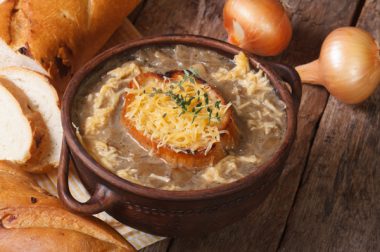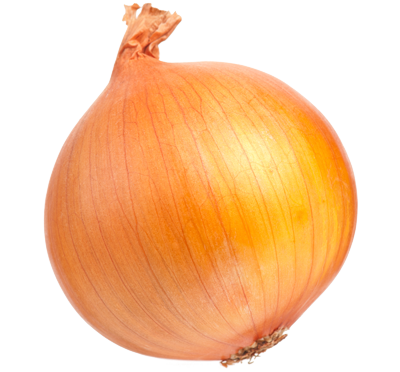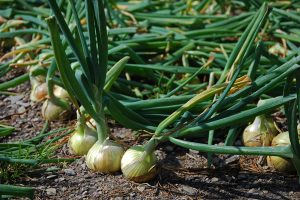Recipes we love
See all recipesOnion tart
A traditional creamy and tasty recipe full of vitamin A (retinol, and beta-carotene) that will help ...
Onions and gherkins
An unconventional dish for those who are looking for vegetables with a distinctive taste....
Health
benefits
A cocktail of antioxidants
Onions contain numerous polyphenols, especially yellow onions, which are rich in quercetin. This compound has been the object of many cancer prevention and cholesterol reduction studies.
Onions also contain:
- vitamin C
- potassium.
- vitamin B9
- fiber, including inulin
Onions are an invigorating food that have antiseptic and anti-infective qualities.
Nutritional
composition
When is the right
time to eat them?
September through April.
Onion are available year-round, but they are in season from September to April.
Vegetable patch or
urban balcony?
Onions are bulbous perennials that grow well in light, well-drained soil and full sun.
To learn everything you need to know about growing onions, read the page on growing advice.
Choosing and
storing onions
Choose your onions well:
They should be firm, with shiny layers and no spots or sprouts.
Properly store your onions:
- Always store them in a dark, dry place so they do not sprout.
- In the refrigerator: One week for spring onions.
Tips and
tricks
How to prepare onions
First peel them, then chop them, mince them, or cut them into rings or quarters. With chopping skills and a knife at hand, you will soon have onions that are ready to use.
The trick for preparing your onions without crying: Rinse the peeled onion or place it in the freezer for a few minutes. The molecule responsible for the tears is highly water-soluble and volatile. You won’t feel a thing!
Cooking times:
- 6 to 8 min: sautéed in a frying pan or wok until translucent.
- 5 min: grilled
Onions go well with…
Raw: Red and white onions, which are sweeter, less spicy, and equally crunchy, go wonderfully in all salads and with other raw vegetables but also with meat carpaccio and fish.
Cooked: Onions are stars in the kitchen—they can do everything! They can be the main ingredient of a dish, whether in a soup, stuffed, on a flatbread, in a gratin or a tart, or made into a jam and served with foie gras. They also go well with pork roast, in slow-cooked dishes, vegetable sautés, stuffing, stews, and savory cakes. They add flavor to omelets, fish, and seafood (such as mussels), not to mention the boost they provide to sauces with their slightly spicy taste.
Can everyone
eat them?

Young children
From six months on, children can eat small quantities of pureed onion in vegetable purees. This taste experience helps children enjoy French onion soup later on in life, as well as the multiple facets of this amazing, aromatic vegetable.
And everyone else
Due to the presence of inulin, a kind of fiber, onions are a fermentable food. Inulin can provoke digestive discomfort in some people, notably those with an irritable bowel. Avoiding onions or reducing onion consumption can lessen those symptoms.
See plenty of other tips for encouraging children to eat vegetables
Where do they come from?
Origins and varieties
Origins: The main onion producers are China, India, the United States, Iran, Russia, Egypt, and Turkey.
Varieties: The taste, shape, and size of onions differ according to climate and variety. The most eaten varieties are:
- Spanish onions: the mildest onion, rather large in size, often eaten raw.
- red onions: the sweetest, often eaten raw.
- pearl onions: this small onion is mainly used in marinades and some stews.
You can also find green onions, characterized by a bulb that has not yet reached maturity. They are sold fresh, in bundles, with their shoots. Green onions are also called scallions. In cooking, they are used the same way as spring onions.



 Peas
Peas  Sorrel
Sorrel  Vegetable garden: growing parsley
Vegetable garden: growing parsley 










